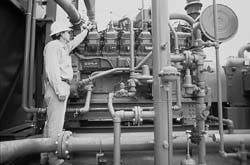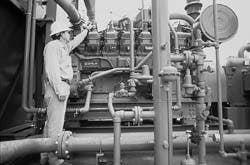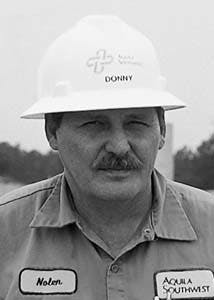HIGH-SPEED ENGINE, COMPRESSOR SETS HELP PIPELINE MEET GROWTH
Charles R. Hayes, Ernesto F. Teach
Aquila Gas Pipeline Corp.
San AntonioDon Nolen
Aquila Gas Pipeline Corp.
Giddings, Tex.
Successful horizontal drilling in the Giddings Austin Chalk Trend prompted the growth in volumes (OGJ, July 10, p. 51).
The equipment has helped Aquila quadruple its gas-gathering volume in 4 years. Additionally, the low-emission engines meet strict air-quality standards imposed in the region.
PIVOTAL ROLE
Aquila's pipeline system employs a 1,900-mile, intercon- necting network that ties together 49 compression stations and approximately 1,600 wells, with stations designed to compress from 5 to 40 MMcfd (Fig. 1)(37554 bytes). Horizontal drilling has pushed Aquila's gas-gathering activity from less than 100 MMcfd in 1990 to more than 400 MMcfd this year.
Aquila's high-speed engines work with the company's slower- speed units to handle the increase in volume.
Currently, 94 compressor sets are used, with capacities ranging between 1.5 and 15 MMcfd. The new gaseous-fueled engines have played a pivotal role in the expansion project by:
- Producing the horsepower needed to compress as much gas as possible per compressor station
- Performing efficiently using wellhead-quality fuel gas
- Operating below exhaust-emission requirements. A key to the volume growth was designing a flexible compression system, allowing gas to be compressed at either low or intermediate pressure, depending on well-flow characteristics and station configuration.
The system enhances production by allowing gas to be routed from one station to another via an interconnecting pipeline system.
Emission control also was a key element of the project, which encompasses a 5,400 sq mile, seven-county region of the Giddings field in southeastern Texas.
Production growth dictated that the project proceed rapidly, with the majority of the compressor sets installed over a 2-year period beginning in 1992. With new state emission regulations about to go into effect, Aquila selected compressor sets that would satisfy those new requirements.
Under Texas State Standard Exemption Six, modified in 1992, each compressor unit must not exceed either 2 or 5 g/bhp of NOx, depending on unit-loading conditions.
To meet peak production without exceeding air-quality standards, Aquila augmented its compressor fleets with units powered by high-speed, low-emission Caterpillar G3512 and G3516 engines.
At stations with 4-MMcfd capacity requirements, the company installed six gaseous-fueled G3512 turbocharged and after cooled engines to power three-stage reciprocating compressors. Each 3,158 cu in., 12 cylinder engine produces 895 hp at a continuous speed of 1,400 rpm capable of compressing 4 MMcfd.
At the same time, 25 G3516 engines were chosen for use at those stations with a 5 MMcfd requirement, three-stage capacity, and a 15 MMcfd, single-stage capacity. The 4,210 cu in., 16- cylinder engines each produce 1,060 hp at a continuous speed of 1,200 rpm.
Both engines produce a maximum emission per emission type of
In addition to the engines, each compressor set consists of a compressor, cooler, control panel, scrubbers, and discharge header piping to send the gas into a high-pressure main line after compression.
The units are skid-mounted and installed on a concrete foundation.
FLEXIBILITY
Aquila Gas acquired the Southeast Texas pipeline system assets from Clajon Gas Co. L.P. in 1990. As production began to pick up in 1990, Aquila set a goal to become one of the leading gas-gathering, processing, and marketing companies in the region.
In keeping with its plans, the company since 1990 has constructed and acquired more than 1,000 miles of pipeline, added one processing plant, expanded an existing processing plant, and added several treating facilities.
Stations are positioned to allow gas to be routed through different pipelines, depending on the pressure required to move it through the network.
Production requires compression flows from the wellhead into common gathering pipelines, and the gas enters the compressor stations via a suction-manifold header. From this header, gas is distributed to individual compressor sets.
If the gas enters the station at low pressure, it is com- pressed in three stages. In the first, gas enters the station at an average of 25-35 psi and is compressed to 100-120 psi. In the second stage, the gas is then compressed to 300 psi and, during a third stage, to a maximum 1,200-psi discharge pressure.
For intermediate-pressure compressors, gas enters the station at 300-350 psi and is single-stage compressed to a max- imum 1,200 psi.
For maximum operating efficiency and safety, the compressor stations are remotely monitored 24 hr/day from an off-site control center in Giddings.
Controlling engine speed and making compressor cylinder clearance adjustments allow each compressor's output to be varied from 3 to 5 MMcfd. As production escalates, added units are brought into service.
With the capability of adjusting the configuration of each compressor station and routing gas from one station to another, Aquila can control production when maintenance is needed. The built-in flexibility minimizes gas loss and helps Aquila achieve its goal of 97% run time availability or better.
Aquila's high-speed engines have also contributed to increased compression capability. With these, Aquila has added upwards of 20% more horsepower to its system compared to its previous engines to increase significantly gas-volume capabilities in its system.
To meet the emissions requirements of Texas State Standard Exemption Six,Aquila needed to limit exhaust emissions to below 2 g/bhp-hr of NOx.
To do that, each G3512 and G3516 engine employs an open- chamber design that enables the G3512 to operate with a 12:1 air/fuel mixture and the G3516 to operate with a 14:1 mixture. This lean mixture reduces combustion temperatures, which in turn reduce the formation of NOx.
Each engine produces approximately 20 tons of NOx based on actual average engine run times of 8,322 hr/year. This allows 438 hr/year for routine maintenance.
At a station with five new compressor sets operating at flail load for a total of approximately 33,000 hr/year, exhaust emissions total less than 100 tons/year of NOx resulting in emissions well below the 250 tons allowed by the state.
Compression ratios of 8:1 on the G3512 engines and 9:1 on the G3516 units contribute to the engines' ability to run at a lean air/fuel mixture. To achieve a high compression ratio, the engines feature deep-cup, high-squish pistons.
A deep cup on the top of each piston produces a high level of turbulence from compression. This in turn allows for more complete mixing and quick, thorough burning of fuel.
High compression is also aided by a turbocharger that forces 50% more air into the combustion chamber compared to a standard emission engine. This, combined with the engine's after cooling system, lowers the engine's inlet air temperature to reduce NOx emissions.
With a high compression ratio, the density of the air/fuel mixture is increased. To create the spark in this dense mixture, high-energy coils deliver 18,000-20,000 v to elongated, high- voltage spark plugs. Electrodes on the spark plugs have bars of precious metal welded to them to accommodate high voltage.
While Aquila has no current plans to add more compressor sets, that situation could change as production characteristics change.



